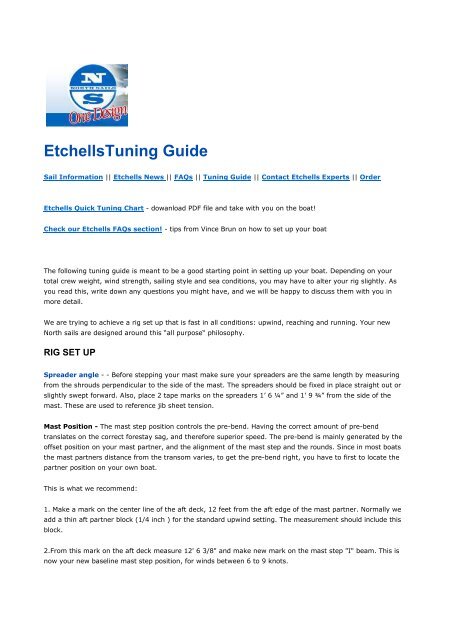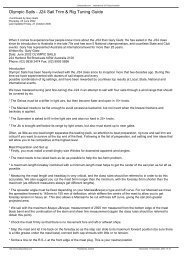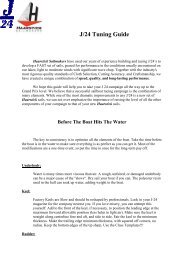North Etchells Tuning Guide.pdf - Sailmaker.org
North Etchells Tuning Guide.pdf - Sailmaker.org
North Etchells Tuning Guide.pdf - Sailmaker.org
Create successful ePaper yourself
Turn your PDF publications into a flip-book with our unique Google optimized e-Paper software.
Mast Step Chart:0 to 5 knots aft 1/4"6 to 9 kts neutral10 to 14 kts forward 1/4"15 to 20 kts forward 1/2"20 kts and above forward 3/4"Mast rake - Once the mast is stepped, lay your forestay taught against the front of the mast, and mark theforestay at the point that corresponds to the upper edge of the black band on the mast at the gooseneck. Hookthe forestay back on and lengthen the headstay until it measures 46” from the corresponding mark at theforestay to the deck ” (46 ½” should be used for newer boats with keel further aft). Before attaching thebackstay, make a similar black band reference mark on the backstay. Remember, that the measurements youare taking correspond to the top of the gooseneck band. In some conditions a headstay setting of 47” hasproven fast. If you change your headstay, please realize that you need to re-locate your mast step position.Upper & lower shroud position and tension - The upper and lower shrouds affect the mast differently. Thetension on the uppers affects the fore and aft bend. Tight uppers (30 on Loos gage) will make the mast stifferfore and aft, and loose uppers (22) will make the mast softer. The lowers affect the amount of middle mast sag(side bend). Having the right amount of middle mast sag is crucial to proper mainsail shape and helm balance.Think of the middle mast sag as similar to how the headstay sag effects the jib. More middle mast sag in lightair powers up the mainsail, and less sag in heavy air helps de-power the mainsail. When you first set your boatup, you want to start out with your uppers tensioned at 25 on the Loos tension gage Model B. The lowersshould be set very loose with 8” of horizontal slop. Once you have tightened your uppers to 25, use your jibhalyard to center your mast in the boat, checking side to side, before you continue with the tuning. Whenchecking shroud tension, pull sufficient tension on the backstay to remove slack in the headstay. Finaladjustment of the lowers should be made while sailing by judging the degree of mast sag. See the chart below.The following chart gives you specifics depending on the wind strength.“ Hole number” refers to the chainplate position the shrouds should be attached to, counting from the front.The lowers should always be in the fourth hole aft on the chainplates. Tension is measured with the Loostension gauge Model B.(See Tension Gauge Conversion Chart)
Wind Speed Uppers tension Lowers0 - 6 knots 20 tension, hole #2 1" sag7 - 11 23 tension, hole #2 1/2" sag12 - 18 27 tension, hole #2 straight mast (no sag )19+ 30 tension, hole #6 mast will sag above spreaderMast blocks - The function of the mast blocks is to adjust the bend in the mast for the conditions. Combinedwith the backstay and mainsheet tension, the mast blocks will control the bend of the mast and sag of theheadstay, which helps the main and jib achieve a fast sail shape for the wind strength. When blocks are addedin front of the mast, (step block raised) the bend is taken out, stiffening the mast for heavier air. This will havea great influence in decreasing your headstay sag. As the blocks are taken out from the front of the mast,(step block lowered) the mast is allowed to bend which moves the draft aft in the main, and adds to headstaysag. The added low bend in the mast, allows the top of the main to become fuller. The net affect is to power upthe main and jib, increasing helm.If the mainsail looks too flat, or the headstay looks too loose, producing excessive weather helm, the mastshould be moved back at the partners Or if not possible (because mast is always back at partners), then themast step should be moved forward. If the mainsail looks full (round in the lower front area) and the headstayis too tight, move the mast forward at the partners or move the step aft.The following chart is to provide a guide for the mast position in the partners when measured forward from theback end of the mast partner.True wind SpeedMast position at thepartnersMast Step0 - 5 knots 1/2” block behind mast Base6 - 10 knots11 - 15 knotsMast blocked ¼” from back ofpartnerMast blocked ¼” from back ofpartnerBase1/4" foward base16 knots and up Mast aft against partner 1/2" forward baseBackstay - The backstay controls the mainsail shape, the amount of twist in the mainsail and the amount ofheadstay sag you will have.Before attaching the backstay, make a similar black band reference mark as you did on the forestay. After youhave the backstay attached, measure down from the black band reference mark and make marks from 48” to56”. Those marks should describe the full range of backstay that will be played; the 48” mark is for very heavywinds and the 56” mark for super light conditions. The measurements in the table below provide a rough rangeof backstay adjustment for different wind velocitiesMAINSAIL SETTINGSWindspeedTraveler Backstay Top batten angleOuthaul
0 - 6knots+ 10" 56-54"Open 3 degrees, tell tales stalling 50% ofthe time1" fromband7 - 11 + 5" 56-54"12 - 16 Center 54-52"Parallel to close 3 degrees, top tell talestalled 30%Parallel to close 3 degrees, top tell taleflying all the time1" frombandMaximum17 - 19 - 2" 52-50" Parallel to close 3 degrees Maximum20+ - 6" 49-48" Open 3 - 6 degrees MaximumMain Cunningham - Cunningham should not be used until 15 knots and more.JIB SETTINGSJib lead - The measurement for an average lead position is 8’ 6 ½” from headstay at the deck to the middle ofthe jib car. To add power to the jib the lead can be moved forward as much as ¾”. Remember though, the leadposition will have to be adjusted with any jib halyard changes. We have found that when the jib lead is setproperly, the foot sets very flat.Jib twist and sheet tension - We sail with two black bands on the spreaders as described in the “Rig set up”section. Measuring from the side of the mast along the spreader to the inside band should be 1’ 6 ¼”. Theoutside band measures 1’ 9 ¾” from the mast to the band. Using these bands allows the leech of the jib to beadjusted while looking through the spreader window of the mainsail, and increases sheet tension accuracy fordifferent conditions. In light air, the leech of the jib should fall just inside the outside band. As the breezebuilds the sheet tension will get tighter, up to the point where the leech of the jib is at the inside band. As thebreeze and sea conditions build, the sheet will be adjusted to keep the leech between the bands. In 18+ knotsthe leech will line up with the middle of the outside band. In huge puffs you may want to be even further out tohelp keep the boat in control.On all our jibs we have placed a leech tell tale between the two top battens. This leech tell tale, will helpdetermine the correct sheet tension. For best performance, the leech tale should be on the verge of stalling atall times.Jib halyard tension - We have a jib halyard with 2 balls at 1” increments. Together with the jib halyard finetune we get plenty of adjustability as the breeze increases and decreases. As a starting point the jib halyardshould be adjusted with the tack of the jib about 3” from the deck. In light to medium winds adjust the halyardso wrinkles are barely visable at each tab.For fine-tuning adjustments of luff tension on the jib the adjusting the tack is recommended. Completelyreleasing the tack control will quickly add power to the sail for acceleration out of tacks.In light to medium conditions, for maximum power, the jib luff should have very little tension and somescallops should be noticed.In breezy conditions, tension the luff quite hard to depower and hold the draft forward.Our latest <strong>North</strong> Sails jibs are made standard with “dual set of tabs” for added wind range and versatility. Usingthe long tabs will add fullness and allow for a tighter headstay in choppy conditions. Generally we use the long
tabs in winds below 12-15 knots. As a general rule, if you are not pulling on the backstay to depower, it isprobably faster to use the long tabs.****** Special note on the top batten pocket for your <strong>North</strong> Sails <strong>Etchells</strong> jib ******Your jib comes with both a long and a short top batten and the pockets for these are mounted back to backnear the head of the sail. Using in the long top batten can increase the effective wind range of your jib and alsogive the sail a longer life when it gets older.We suggest always using the short top batten in your jib and then when the winds gets up to the top of therange of the sail or when the sail gets a little older add the full length top batten and sail with both in place.Any questions, please give us a call.SPINNAKER SETTINGSRig setup while running - Getting the mast raked as far forward as possible is critical to downwind speed.Take out all the blocks in front of the mast (completely lower the step block) after you get the spinnaker up.Ease the backstay off until the mast just rest on the front of the partners. The tip of the mast has movedthrough several feet, and the entire mast is now angling forward in the boat. To keep the mast from jumpingaround, it is common to have a separate piece of line attached to your jib tack shackle with a clip at the otherend. Lower the jib to the deck, and attach the clip to the jib halyard shackle on the jib head. Pull the jibhalyard tight.Keep the inboard end of the pole approximately 30” above the gooseneck band. Under 8 knots of wind, thepole angle should be about 2 - 4” lower at the outboard end. In 8 - 13 knots of breeze the pole should be aboutparallel to the water. In over 13 knots, the pole should be raised as much as 6 additional inches at theoutboard end.CARE OF YOUR SAILS - Always store your sails away from the sun and make sure they are clean andcompletely dry. Be sure that you always "roll " your upwind sails. This will help then last longer and remainwrinkle free. If you have any questions or comments about our <strong>Etchells</strong> <strong>Tuning</strong> <strong>Guide</strong>, don't hesitate to contactus anytime.
















